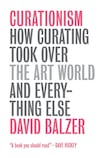
Something happened in the art world in the latter half of the 20th century. Just as popular music began to be less about those who created it (musicians) than those who presented it (DJs), artists saw their status and power encroached on by a new, swiftly romanticised figure: the curator. This paradigm shift went far beyond the galleries and biennials: it has altered the texture of popular culture, consumerism and daily life.
So, at least, runs the argument of Curationism: How Curating Took Over the Art World and Everything Else, which maps the factors behind the rise of the art curator, the ubiquity of the verb "curate" and its derivatives, and the cultural "aura" they propagate.
David Balzer is restrainedly polemical in tenor, with occasional flare-ups of disdainful exasperation. He is critical of the visibility and power of the curator in contemporary art since the mid 1990s and of the often unacknowledged affinities between the avant-garde and capitalism.
Balzer is convincing as long as he confines himself to the art world, but when he ventures beyond the gallery walls he seems so acutely sensitised to “curationism’s influence” that he sees evidence of it pretty much everywhere. Consequently, his critique suffers from a too-nebulous definition: if curationism is all things, then it has no weight as a concept.
Before explaining “how we got to this point”, Balzer proffers an absorbing portrait of the kingpin Hans Ulrich Obrist, the curatorial Kanye West – “as close to a rock star as a curator can be”. Globe-hopping, sleep-shunning and coffee-quaffing, Obrist parlays with the great and the glamorous, churning out books in the pauses between whizzing through galleries to declare, at a glance, what’s hot and what’s not.
In Balzer’s reckoning, “HUO” is not only the apotheosis of the star curator but also “the discipline’s end- game”. Curationism, he contends, is in the process of devouring itself, just as it devoured the avant-garde it initially sought to advocate.
Advent of the avant-garde
In the prodigious years of the modernist project early in the last century, art (primarily in Europe) burst forth in a rainbow of enticing isms, from future to fauve, cube to dada. Pioneering “institutional curator-directors” such as Alfred H Barr, at MoMA in New York, took it on themselves to seek out, filter and present to a virgin public the avant-garde’s most flavoursome fruits.
In danger of becoming the perceived enemy of this avant-garde, museums were eager to modernise. (Not everyone was oblivious to the irony. Gertrude Stein said that “you can be a museum or you can be modern, but you can’t be both”.)
In the 1960s and 1970s newly affluent and amenable to Bohemianism and experimentation, North America took pole position in the art race. Suspicious of the commodification and institutionalisation of art, American artists moved away from the object, rejecting the “formalist fetishism” of Barr and his ilk, and towards conceptualism. Declaring the art object exhausted, they strove to strip away “the object’s objecthood to get at the edgy essence of creativity and ideas, and to prevent art being consumed and packaged by the bourgeoisie”.
With art newly dematerialised, fragmented and factionalised, anxiety set in about who would separate the good from the bad, the genuine from the half-assed. Enter the curator, the “imparter of value . . . who insists on value, and who makes it, whether or not it actually exists”.
In the 1980s “Wall Street was making it new” and the “avant-garde impulse inherent in American capitalism” was generating unprecedented wealth and consumption. Banks, meanwhile, were amassing vast art collections, and the art world’s complicity in the capitalist economy had never been more brazenly bare.
Star curators
Abetted by the new-found glut of art consumption, the critic and the dealer became the glitzy decade’s key players. In the mid 1990s their oligarchy would in turn give way to the HUO-style star curator – and thus began, in Balzer’s schema, the “curationist moment” proper. The “supervisibility of the curator” would last for almost two decades.
The idea spread: soon “curate” was everywhere. Music festivals, US grocery chains such as Trader Joe’s and Whole Foods, pop colossuses such as Jay-Z and Madonna, and even vampires embraced the lingo, practices and aesthetic of curationism.
As Balzer sees it the curatorial aura permeates seemingly everything, from the wedding of Kanye West and Kim Kardashian (Kanye is “nothing if not an artist-curator”), to Gwyneth Paltrow’s “conscious uncoupling” from Chris Martin. Irish Yes campaigners in the recent referendum may be surprised to hear that their struggle, too, was part of the curationist revolution: “There is an argument to be made for the vehement movement behind marriage-equality rights in the last decade as being a fight for the right to curate.”
Social media and the wider digital world, Balzer contends, are the frontiers of the curationist expansion: we curate our own selves, just as we seek individualisation through our fashion and consumption choices. Signs of resistance can be discerned in such phenomena as the “normcore” anti-fashion movement, with its Warholian injunction to become boring in protest at the compulsions of curation-capitalism.
Art appears to be moving away from the concept, back to the object, undermining the need for curators’ assumed authority.
Balzer wraps things up by urging us to join in the anti-curationist counterstrike. Unfortunately, his suggestion about how this might be achieved – “stillness”, basically – is as hollowly nebulous as his hyperexpanded conception of curationism.
Nonetheless, the author is probably correct in his prognosis that the reign of the curator, in its more overt and reactionary aspects, is on the wane. Perhaps this smart, stimulating book will accelerate the process.
Rob Doyle's second book, This Is the Ritual, is due to be published in January by Bloomsbury/Lilliput











